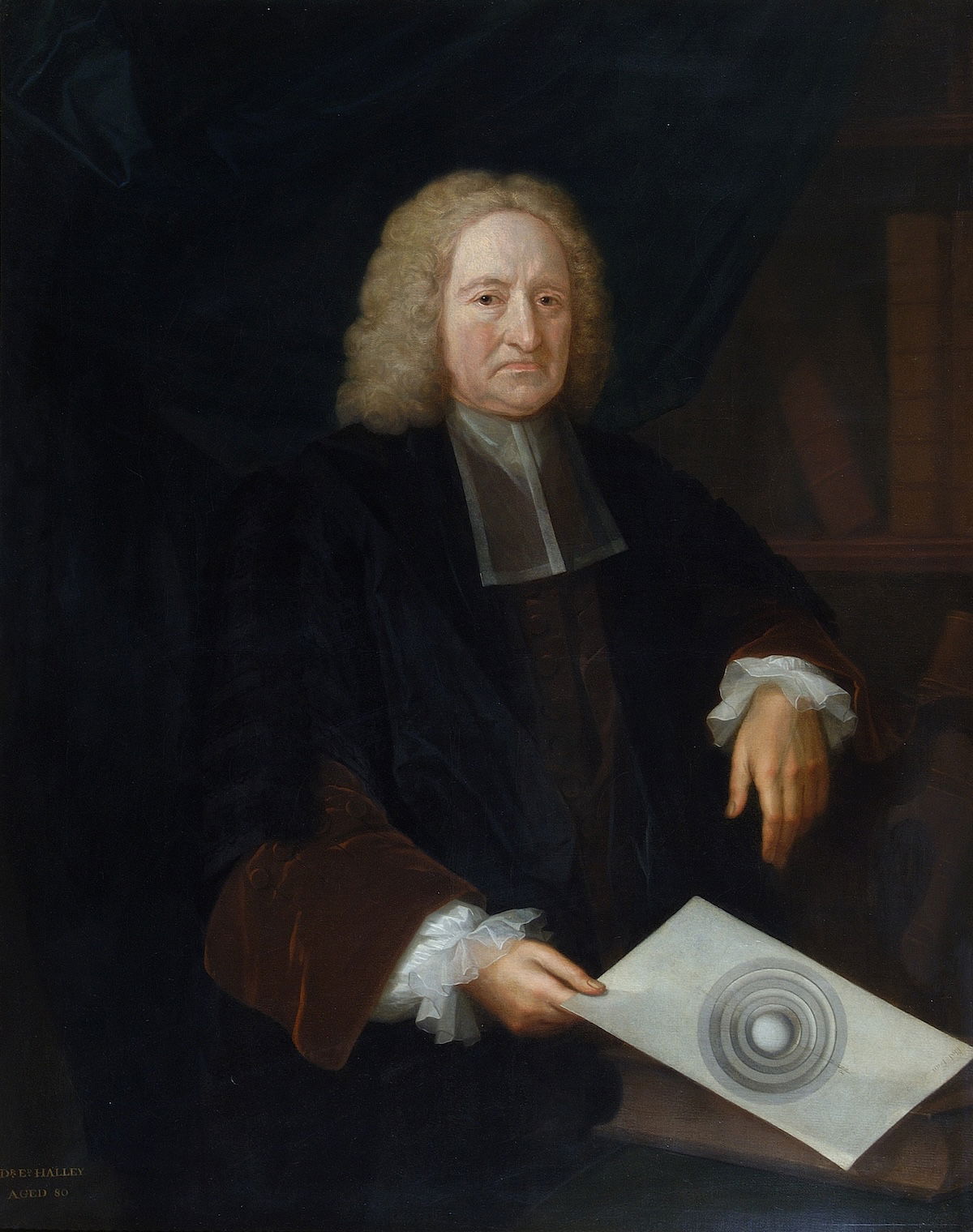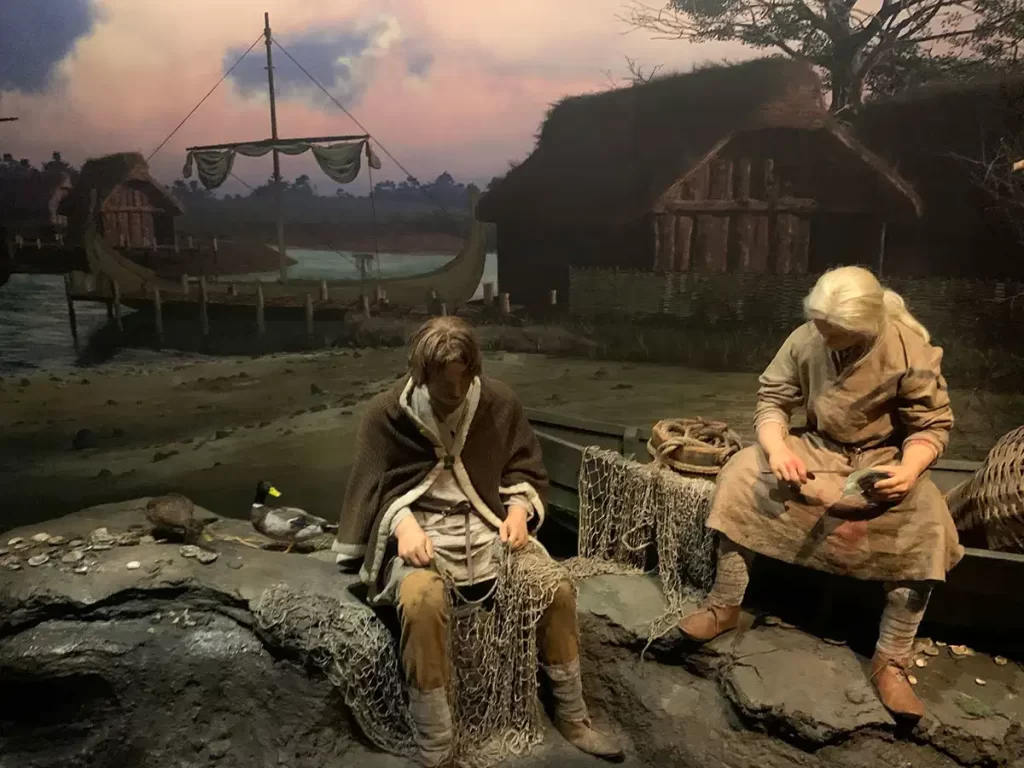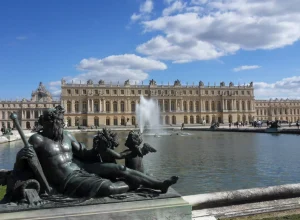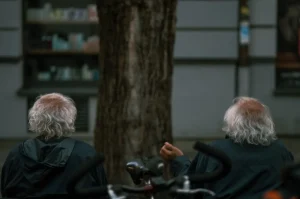What if the ground beneath your feet wasn’t solid at all, but a shell wrapped around hidden suns, green valleys, and ancient beasts? The notion sounds like pulp fantasy, born for lurid paperbacks and Saturday matinees. Yet its roots reach back to one of the most respected scientific minds of the seventeenth century. From there, the idea tunneled through lecture halls, polar dreams, dime novels, and flying-saucer folklore, surfacing again and again whenever curiosity and discontent met at the edge of the known world.
This is the long, winding story of Hollow-Earth Theory—how a practical guess about magnetism became an endlessly reinvented map of our anxieties and desires.
Halley’s Guess

Begin in London, November 1691. Edmond Halley—the same Halley who used Newton’s mechanics to predict the return of a comet—stands before the Royal Society with an “Extravagant or Romantick” hypothesis. Sailors and merchants have complained for years that compasses misbehave; magnetic north seems to drift and twitch, confounding navigation and commerce alike. Halley proposes a tidy mechanism: what if Earth’s magnetism isn’t fixed in a single, simple core? What if there are additional magnetic poles, their motions slightly out of step with the surface?
Those poles, he suggests, might belong to a free-spinning inner sphere. Picture Saturn and its rings, held together by gravity, each part turning at its own pace. In Halley’s mind, Earth could be something like that: concentric layers rotating in concert, generating complex magnetic effects.
Then comes the bolder step. Suppose there isn’t just one inner globe, but a set of nested spheres—matryoshka dolls beneath the crust. Suppose, too, that these spheres are habitable, warmed and lit by “peculiar Luminaries,” a poetic nod toward Virgil’s underworld and, in a later flourish, a conjecture that some of that inner light may burst upward as the aurora borealis. It is a daring blend of physics, classical imagination, and theological thrift: an economical Creator would waste no square mile of real estate.
Halley’s audience is intrigued but not persuaded. Across the Atlantic, the Puritan polymath Cotton Mather will dutifully summarize the idea in The Christian Philosopher (1721) before backing away with a sigh: “it’s time to stop, we are got beyond Human Penetration.” Still, Halley’s proposal—habitable shells, magnetic mysteries, heavenly lights underground—provides a coherent recipe for speculation. He has given later thinkers a scaffolding sturdy enough to hang fancier dreams upon.
A Doorway at the Poles
The idea sleeps for a century, then wakes in the hands of John Cleves Symmes Jr., a trader and former U.S. Army officer with a showman’s flair. In April 1818, from St. Louis, Symmes issues a circular “TO ALL THE WORLD!” declaring that Earth is hollow and “habitable within; containing a number of solid concentrick spheres.” Unlike Halley, he wants to go see for himself.
Symmes adds a crucial innovation: enormous openings at the poles. The North and South Poles, he claims, are the mouths of vast tunnels into the inner world. The vision is equal parts science and frontier fantasy—a practical expedition plan married to the promise of new land. This is the young American republic, after all: Ohio carved from speculative purchase, Louisiana bought wholesale from France, the map expanding westward like a chest filling with breath. Why not expand inward, too?
Symmes petitions Congress for funds and writes to luminaries like Humphry Davy and Alexander von Humboldt for endorsement. He lectures tirelessly in Cincinnati and beyond, arguing that the interior might be temperate and rich. The nation listens, chuckling and cheering in equal measure, but the money never arrives. Symmes dies in 1829, his polar hole unvisited. The dream, however, is durable. In the 1870s, his son—named, with a flourish fit for exploration, Americus Vespucius Symmes—revives the campaign. Newspapers play along. “Symmes’s Holes” become a meme before memes, a running joke with a stubborn kernel of hope.
Utopias Inside Out
While expeditions stall, storytelling surges. The inner Earth becomes a stage where social arguments can be acted to the extreme. In 1820, the pseudonymous Symzonia sends a patriotic American through Symmes’s northern portal only to find “Internals” whose virtues expose the visitor’s own follies—Swift by way of Cincinnati. Decades later, as Symmesian notions trend anew, writers funnel pressing debates down the hole.
In Mizora (1880), Ohio schoolteacher Mary E. Bradley Lane imagines a matriarchal civilization beneath the crust, a polished society built on science and education that gently, if didactically, rebukes the inequalities of her day. William Mill Butler’s Pantaletta (1882) answers with a reactionary mirror-world called “Petticotia,” where women rule cruelly over men. The inner Earth proves ideal for utopias and dystopias alike: a blank slate where the author’s preferred order can be demonstrated, or an enemy’s worst-case world can be exaggerated into warning.
Not everyone filing into the hollow is a novelist. Earnest copycats—often businessmen with an appetite for heterodoxy—publish treatises that treat the theory as an open question. Franklin Titus Ives, a Connecticut merchant, writes The Hollow Earth (1904), blending personal conviction with diagrams and polemics. Washington L. Tower’s Interior World (1885) wraps children’s adventure around physics lessons. Reviewers scratch their heads: which parts are straight, which sly? Meanwhile, legitimate science is itself unsettled—Is Earth’s core liquid? Solid? Something else?—and into those gaps, Hollow-Earthers plant their flags. In 1892, even the respected geologist Charles Lapworth muses (cautiously) about concentric shells as others have proposed.
By now, Halley’s neat stack of habitable layers has usually been simplified to a single vast hollow, a grand cavern fit for cities and seas. The poles still beckon as entry points; the inner light still glows.
When the Poles Are Found
The early twentieth century brings the heroic age of exploration to a close. Whether by air, ice, or argument, explorers lay claim to the poles. Whatever controversies linger about who reached which point first, one thing becomes clear: no yawning “Symmes Hole” awaits an expedition. Grand entrances give way to plain ice and wind. On the surface, the Hollow Earth loses a measure of plausibility.
But in fiction, it is ripening. In 1914, Edgar Rice Burroughs publishes At the Earth’s Core, the first of his Pellucidar adventures. There, beneath our feet, the sun hangs fixed in the sky, time circles strangely, and prehistoric monsters prowl—dinosaurs, sabre-toothed cats, cavemen with complicated loyalties. Tarzan will later visit. Boys and men (and plenty of women, too) turning pages by lamplight will follow for decades, eager to enter a world where the rules of geology and society can be rewritten with one bold premise.
From Caverns to Saucers
Then comes another turn. Between 1945 and 1948, the magazine Amazing Stories—helmed by the indefatigable showman-editor Raymond Palmer—publishes the “Shaver Mystery,” tales by the deeply troubled and fervently imaginative Richard S. Shaver. These stories describe subterranean realms inhabited by malevolent beings whose technologies warp human minds. Are they fiction? Are they revelations? Palmer coyly refuses to settle the question. The ambiguity proves electric. Readers write in with their own testimonies and nightmares. The inner Earth, once a divine economy or a utopian playground, becomes a maze of malice.
In 1947, the term “flying saucer” bursts into the headlines, and by the 1950s a curious inversion takes hold: some saucers aren’t descending from cold, indifferent space; they are ascending from tunnels and caverns. Palmer, having moved on to new ventures, publishes Flying Saucers magazine and, in a December 1959 issue, pushes the line he and Shaver have been hinting at for years: UFOs are denizens of the Hollow Earth, darting in and out via Symmes’s polar gates. He cites a garbled story of a pilot who supposedly flew through one such hole into a lush inner paradise—and spotted a mammoth.
Two years later, Palmer’s The Hidden World reprints Shaver’s tales as fact. The inner Earth is no longer a promised domain of colonists or philosopher-navigators; it is a haunted basement crawling with hostile caretakers. The dream of new territory has become a warning. The fear that what lies beneath is not ours and not friendly finds its myth.
More Stories
Why the Hollow Endures
It would be comforting to shelve Hollow-Earth Theory as a curiosity: a chain of confident mistakes, a parade of fads, a museum of outlandish maps. But the idea keeps returning, not because people fail to learn, but because it is so serviceable. It answers different needs in different eras.
For Halley, it was a practical hypothesis—an elegant if incorrect attempt to reconcile data. For Symmes and his American audiences, it was an extension of the frontier, a cartoon of Manifest Destiny that swapped wagons for sledges and buffalo grass for polar ice. For utopians like Mary E. Bradley Lane, the hollow offered a laboratory where hierarchies could be reversed and virtues made visible. For pulp readers, it was a reliable thrill: a place where the ancient never died and the modern never quite fit. For Palmer and Shaver, it became a conspiracy-proof vault, a realm where a beleaguered sensibility could claim secret knowledge against a hostile world.
Across those transformations, one thread holds. The hollow interior is not simply a geological proposition. It is a symbolic space—a drawer in the cultural desk where we put things that do not fit elsewhere: our fears (aliens, tyrannies, monsters), our hopes (new lands, better governments, kinder technologies), and our suspicions (that official maps leave out the most important rooms).
This explains the theory’s resilience even as science fills in the blanks. Seismology traces earthquakes through the planet, revealing a dense, hot core rather than habitable shells. The aurora dances are traced to solar winds and Earth’s magnetosphere, not inner suns. Yet a literal truth can fade while a figurative truth flourishes. We still talk about “underworlds”—of crime, of memory, of myth—because the metaphor fits. We still imagine hidden infrastructures—tunnels, backrooms, server farms—because modern life depends on systems we barely see.
The Hollow Earth offers the oldest version of that intuition: beneath the surface of the ordinary lies a complicated, consequential machinery. Sometimes we name it God’s economy; sometimes we call it empire or industry; sometimes we fear it as a cabal. The map changes. The feeling persists.
The People Behind the Map
It’s also worth noticing who kept the map alive. Halley, the establishment scientist, steps forward first. After him come the self-taught lecturers, the small-town printers, the merchants with money to risk on pamphlets, the novelists, the schoolteachers, the pulp editors, the obsessives. These are democratic characters in a democratic story. They claim a right to propose, to argue, to imagine. They are often wrong—gloriously, entertainingly wrong—but their confidence signals something essential about the culture that produced them: knowledge-making as a public sport, an arena where boldness sometimes wins the crowd even when it loses the game.
There is both nobility and danger in that posture. The nobility lies in the invitation: think for yourself; ask naive questions; change the premise. The danger lies in the refusal to be corrected, the delight in secrecy for its own sake, the elision of evidence into vibe. Hollow-Earth Theory has hosted both instincts. It has sheltered gentle utopias and shabby grifts, heartfelt thought experiments and hard-nosed hoaxes. It reflects us because it is us: inventive, stubborn, lonely, hopeful.
Back to the Surface
So what sits beneath the planet’s crust? Not inner suns or happy cities, not polar portals or mammoths grazing in secret valleys. Beneath us is pressure and heat, metals and minerals, motion and magnetism of a different kind than Halley imagined. But if you listen closely, another answer hums alongside the scientific one.
Beneath the surface lies a story—about curiosity and its limits, about the power of an idea to leap from a sober paper to a traveling lecture to a romance novel to a sensational magazine, about the way maps can guide us even when they misdescribe the land. The Hollow Earth is one of those stories. It reminds us that the world we inhabit is made not only of rocks and rules, but of the pictures we draw in our minds and share with each other when data runs thin and wonder runs high.
And when you stand on a winter night and watch the sky spill green and violet over the horizon, it is not so hard to forgive Halley his romance. He wanted the heavens to echo underground; he wanted elegance at the core. We all do, sometimes. The difference between science and speculation is what we do next—measure, test, and change our minds—or spin another tale and go looking for a door that isn’t there.
The tales, at least, will keep coming. They always have.
Key Takeaway
The Hollow Earth began as a reasonable (if wrong) solution to a real puzzle and evolved into a flexible myth-space where each era staged its dreams and dreads—from new lands for a young republic to secret cities of pulp adventure to saucers rising from caverns. Science closed the literal hollow, but the imaginative one remains: a reminder that when we peer past the crust of certainty, what we often find is ourselves.










































